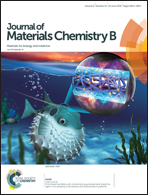Polymeric chemosensor for the detection and quantification of chloride in human sweat. Application to the diagnosis of cystic fibrosis†
Abstract
We have developed a new extremely hydrophilic polymeric film suitable for the detection and quantification of chloride in human sweat directly on the skin. The film, or membrane, has chemically anchored 6-methoxyquinoline groups as chloride responsive fluorescent motifs. We have prepared the sensory material from a standard vinyl copolymer, by a convenient and easy solid-phase reaction. The sensory material has a water swelling percentage of 700%, facilitating an immediate detection of chloride, is reusable for at least 6 cycles and can be handled without care by unskilled persons. The initially high fluorescence of the material decreases in the presence of chloride, allowing the quantification of chloride concentration by using the colour definition of a digital picture or a fluorimeter. The suitability of the material to perform quantitative chloride analysis of human sweat by putting it in contact with the skin offers promise for its application in the sweat test used for the diagnosis of cystic fibrosis (CF).



 Please wait while we load your content...
Please wait while we load your content...